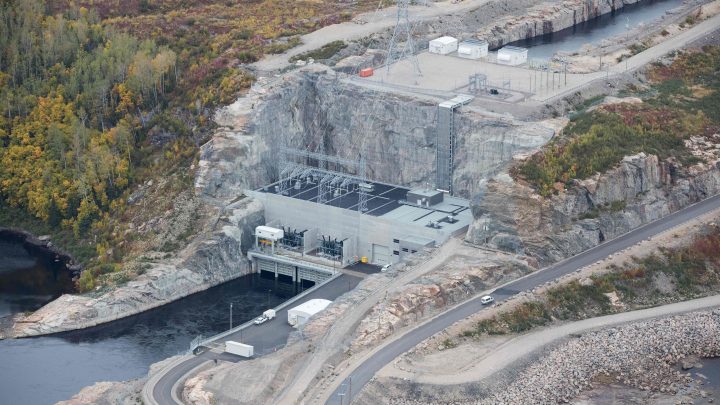
As weather gets less predictable, hydropower dams look to new forecasting techniques
As weather gets less predictable, hydropower dams look to new forecasting techniques

Global demand for fossil fuels is expected to peak by the end of this decade as we transition to cleaner sources of energy. One source we already heavily rely on is hydropower, but, as weather becomes more unpredictable, dam operators and planners have the increasingly challenging task of managing the extremes of flood and drought.
Climate journalist Saqib Rahim has been writing about new forecasting techniques that might help those hydropower planners. He joined Marketplace’s Amy Scott to talk about forecast-informed reservoir operations, or FIRO. An edited transcript of their conversation is below.
Amy Scott: So how, generally speaking, is the climate crisis making it harder to manage these large dams that often are an important provider of power for their communities?
Saqib Rahim: I’ve been covering renewable energy for a while. And the way that people always talk about hydropower is it’s sort of the ol’ reliable of the renewable energy world. Something like 60% of all renewable energy in the world comes from hydropower. But the thing is, dams, by definition, have been built to previous climate regimes. And we’re now entering this new climate regime.
Scott: You write about this pilot program with the U.S. Army Corps of Engineers that’s meant to help dam operators better manage water when it’s coming or when there isn’t enough of it. It’s called forecast-informed reservoir operations. How does that work?
Rahim: Yeah, FIRO! Fun name. The way it works is it takes advantage of improvements in weather-forecasting technology. Now, over on the West Coast, the major way they get rain and snow is from these things called atmospheric rivers. Those were in the news earlier this year. I think there were 31 of them in California that just hit back to back. And these enterprising scientists are sort of flying out above these storms and dropping sensors into them. And what you get is a really detailed picture of what a given atmospheric river is doing. You can tell kind of where, when and how much water is going to hit.
Scott: Give me an example of how this program helps someone at a dam predict what’s coming and act accordingly.
Rahim: So traditionally, the way you run a dam is you basically aren’t allowed to use weather forecasts. You’re supposed to —
Scott: Wait a minute, that is so weird. Can you just say why you weren’t actually allowed to use weather forecasting?
Rahim: Yeah, that’s a traditional way of doing things. Weather forecasts were not considered that reliable. And if you basically make a bet, and you’re wrong about that bet, really dangerous things can happen.
Scott: Hmm. OK. So now FIRO comes along. And it says, “Yeah, please use these forecasts.” Makes sense.
Rahim: Yeah. FIRO is a way of seeing if we can use weather forecasting to get better results. And what they’re finding is, yes, you can get better results. I talked to a dam operator in Northern California who said, “I now have visibility five days out that I used to have at only two.” You can do whatever you want with those three days. You can either use some of that water to run your hydropower turbines, you can bank some of it for drinking water, you can do any number of things that kind of hew to what your goal is as a dam.
Scott: And so you talk in the story about Prado Dam near Los Angeles and how it was able to take advantage of forecasting. Can you describe how this pilot allowed the dam operators to do something they couldn’t have done before, or not as well?
Rahim: This story is so cool because Prado Dam is a really, really old dam. But essentially what they did was, without any new infrastructure, they used the weather forecast to see that these atmospheric rivers that are coming for us are pretty well spaced out. Now, why that matters at Prado Dam is they have this network of, colloquially I would say, sponges, where they can release water into the sponges and they’ll soak into the ground. And now you’ve got groundwater. Because those storms were so well spaced out and they knew that, they were able to time the exact cadence of releases into those sponges, as I’m calling them, and they were able to bank really the maximum amount of water that you possibly could.
Scott: So this pilot now is at half a dozen sites in the U.S. Do you see this scaling up significantly?
Rahim: They say they’re scaling up significantly. Now, one thing to keep in mind here is that atmospheric rivers have gotten a lot more predictable in the last 10 years, but a lot of the precipitation events in other parts of the United States have not. For example, Midwest thunderstorms; those are beyond the cutting edge of what scientists feel they can forecast confidently right now. So the challenge for all the FIRO pilots going forward is to basically get better at predicting Mother Nature and integrating that into how the reservoirs in that part of the country operate.
There’s a lot happening in the world. Through it all, Marketplace is here for you.
You rely on Marketplace to break down the world’s events and tell you how it affects you in a fact-based, approachable way. We rely on your financial support to keep making that possible.
Your donation today powers the independent journalism that you rely on. For just $5/month, you can help sustain Marketplace so we can keep reporting on the things that matter to you.












